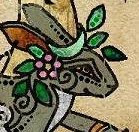 [Quote below taken from Sekhmet post at Arcane Archive]
[Quote below taken from Sekhmet post at Arcane Archive]"Sekhmet is usually written as the Skhm Sceptre combined with a human placenta (the monoliteral character 'kh', the Germanic hard h as in the Scottish word 'loch', a symbol of birth), a loaf of bread (the monoliteral character 't', representative of agriculture and the priestess-women, or witches, who invented agriculture, as well a determinative indicating feminine or womanhood or Goddess-hood), and a determinative of the Goddess Sekhmet (a picture of a lioness-headed woman seated upright with Her knees near Her
chest, with the uraeus cobra encircling the circle of the sun resting on Her head).
Her name literally means "Strong Female", usually translated as "Lady of Strength" or "Lady of Power".
There is also an older form written as a down-pointing arrow and a loaf of bread. This early name can be confirmed by both artwork and literature in museums around the world."
Since it is clear from the archaeological record that Sekhmet is very old-- She certainly predates her 'husband' Ptah-- I think we are looking at a very archaic Goddess of the Hunt in Her. Also, since there are several other female deities in ancient Egypt who have arrows (or bows and arrows) as symbols-- Neith being one-- I think it is pretty clear that in ancient times, hunting was not specifically a male activity. It is certainly easy to see how archaic female hunters could have identified with the Lioness who hunts for her pride, the young cubs and the pride-male not taking part in the chase and downing of prey. The first archaeologists (exclusively men), looking through their male-privilege world-view, always assumed that any time hunting was done in the past, it was always done by men. This idea is completely chauvinistic, and doesn't take into account what is plainly seen in the archaeological and mythological record.
A fact that springs to the fore when one looks at world mythology, is that the bow is everywhere associated with a Goddess-- from the Sami in Finland to Siberia to ancient Egypt, Greece and Rome, it is a Goddess who is the Lady of the Hunt and the Owner of the Bow. I would therefore posit that it was women-- women who figured out how braid and spin fibers into cording-- who developed the bow as a female hunting device, along with snares and slings, which also use cording, and which also have a tradition of female use, David's sling notwithstanding.
The modern 'idea' that 'men are the hunters' because they supposedly have better spatial-relationship viewing skills is utterly fatuous. Women, like men, have two eyes, and thus have the necessary binocular vision to accurately gauge distance and bring down prey. This is borne out among Native American tribes, where women do sometimes actively hunt. Today there are also women around the world who use both bows and rifles to hunt with, and they are just as successful in their hunting pursuits as men are.
Also fatuous is the modern mythology that women are always gentle nurturers. Just take a look at Kali, Aphrodite (who was originally a Sex-and-Death Goddess), Durga, Neith/Nit... and Sekhmet.
The bottom line is that human emotion-- love, anger, aggression, grief-- has no gender. When a woman hunts, it is a completely feminine activity, just as when a man grieves, it is a completely masculine one.
I praise Sekhmet, my Mother, who has released my Awareness from the sexualized delusion that accompanies modern thinking about emotion and human nature, and I hold Her Arrow and wear Her Claws with pride of female birthright.
Sat, Sekhmet, Sahut,
Sekhmet Neseret Djet!
[T'Zairis Shirzah, the Naked Lioness,
Shamaness-Standing-Before-Sekhmet]



No comments:
Post a Comment